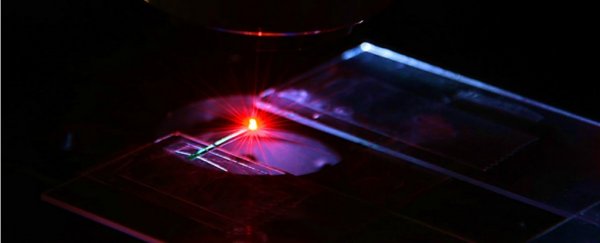Researchers have developed a blood laser, using human blood and a fluorescent dye called indocyanine green (ICG), and it could help doctors search for tumours in the body.
So how does this new 'blood laser' work? To make a laser, all you need is a source of light, an amplifying material, and a reflective cavity. Researchers from the University of Michigan used an FDA-approved dye called ICG, and mixed it with the blood to play the role of the amplifier.
"Without blood, just ICG, it doesn't work at all," one of the researchers, Xudong Fan, told Jacob Aron at New Scientist.
Once you have your cavity, an amplifying material, and source of light, your laser is in business.
As Jennifer Ouellette explains for Gizmodo, once you zap the medium with light or electricity, it boosts the atoms to higher energy levels, known as an 'excited' state.
"Then photons are pumped into the cavity. If one strikes an excited atom, that atom will drop back down to its ground state, releasing a second photon of the same frequency and direction," she says.
Eventually, these continue striking other energised atoms, releasing more protons until they create a burst of laser light.
When Fan and his team placed the blood and ICG in a reflective cylinder, and shot at with a near-infrared light beam, the blood emitted light, creating a potential new technique for doctors use to search for tumours.
Because ICG accumulates in blood vessels, areas with large amounts of blood vessels, like tumours, should light up like a Christmas tree.
The technique would simply involve injecting the ICG into the patient, and shining a light beam at the skin, while checking an infrared camera for the glow.
The blood laser has yet to be tested in live animal tissue, because they have to figure out what will play the role of the reflective cavity. But Fan says that gold nanoparticles could be useful for the job.
"Eventually, we are trying to do it in the human body," he told New Scientist, adding that they need to figure out how to ensure that the light produced by the blood laser isn't too strong.
"You don't want to burn the tissue," he said.
Blood isn't even the only strange material that's been used to make lasers - back in 2011, a different group of researchers used a living kidney cell to amplify the light, and in the 1970s, two scientists even made a laser using jelly.
If they can help us locate and diagnose cancer more effectively, we're all for it.
The team published a paper on their progress at the Optical Society of America Technical Digest.
